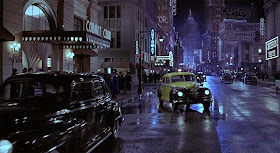In honor of the latest LA earthquake and that Noah thing (cause... effect... cause), let’s talk about disaster films. Here are my favorites:
1. Voyage To The Bottom Of The Sea (1961): This is one of those films I can watch over and over and over. When the Van Allen belt, which surrounds the Earth, catches on fire, the planet starts to bake. The experimental submarine Seaview must launch a missile to detach the Van Allen belt from the Earth, but it seems that everyone wants to stop them. Staring Walter Pidgeon, Barbara Eden and Kane from Buck Rogers, this is a fun film.
2. The Last Voyage (1960): This is probably the best shipwreck movie ever. Staring George Sanders and Robert Stack, this is the story of the SS Claridon, which begins to sink when one of her boilers explodes. Awesome effects (because they really sank the ship) and solid drama combine to blow the doors off Titanic.
3. Airport (1970): I know they claim they used Zero Hour, but this film IS the serious version of Airplane and it’s a really good film too. Basically, anything that can go wrong will go wrong on this snowy night at the Airport Burt Lancaster operates... with help from an all-star cast.
4. The Crazies (2010): A remake of a George Romero film, this one stars Timothy Olyphant as a local sheriff who finds his whole town going crazy because a military plane crashed while carrying some bad stuff.
5. The Poseidon Adventure (1972): What a cool idea! A rogue wave knocks a cruise ship completely upside-down. Now the survivors must race to the bottom of the ship, which is now the top, to survive.
6. The Core (2003): Imagine if you will, that Stanley Tucci stopped the Earth’s magnetic core from spinning and now Aaron Eckhart, Hilary Swank, Delroy Lindo, and Bruce Greenwood need to save us by setting off nuclear bombs. It’s an entertaining if entirely stupid film.
7. Knowing (2009): This film scores on two points in a big way. First, the way Nicholas Cage discovers what is going on is very smart, especially for a modern film. Secondly, the effects in the minor catastrophes throughout are impressive.
8. Outbreak (1995): I hate the “evil military” aspect of this film, but the virus stuff is top notch as Dustin Hoffman roams far and wide to try to stop a killer virus on the loose in the US of A.
And if you want a refresher of others you’ve seen and long since forgotten, here’s a pretty decent list: LINK.
Thoughts?
1. Voyage To The Bottom Of The Sea (1961): This is one of those films I can watch over and over and over. When the Van Allen belt, which surrounds the Earth, catches on fire, the planet starts to bake. The experimental submarine Seaview must launch a missile to detach the Van Allen belt from the Earth, but it seems that everyone wants to stop them. Staring Walter Pidgeon, Barbara Eden and Kane from Buck Rogers, this is a fun film.
2. The Last Voyage (1960): This is probably the best shipwreck movie ever. Staring George Sanders and Robert Stack, this is the story of the SS Claridon, which begins to sink when one of her boilers explodes. Awesome effects (because they really sank the ship) and solid drama combine to blow the doors off Titanic.
3. Airport (1970): I know they claim they used Zero Hour, but this film IS the serious version of Airplane and it’s a really good film too. Basically, anything that can go wrong will go wrong on this snowy night at the Airport Burt Lancaster operates... with help from an all-star cast.
4. The Crazies (2010): A remake of a George Romero film, this one stars Timothy Olyphant as a local sheriff who finds his whole town going crazy because a military plane crashed while carrying some bad stuff.
5. The Poseidon Adventure (1972): What a cool idea! A rogue wave knocks a cruise ship completely upside-down. Now the survivors must race to the bottom of the ship, which is now the top, to survive.
6. The Core (2003): Imagine if you will, that Stanley Tucci stopped the Earth’s magnetic core from spinning and now Aaron Eckhart, Hilary Swank, Delroy Lindo, and Bruce Greenwood need to save us by setting off nuclear bombs. It’s an entertaining if entirely stupid film.
7. Knowing (2009): This film scores on two points in a big way. First, the way Nicholas Cage discovers what is going on is very smart, especially for a modern film. Secondly, the effects in the minor catastrophes throughout are impressive.
8. Outbreak (1995): I hate the “evil military” aspect of this film, but the virus stuff is top notch as Dustin Hoffman roams far and wide to try to stop a killer virus on the loose in the US of A.
And if you want a refresher of others you’ve seen and long since forgotten, here’s a pretty decent list: LINK.
Thoughts?

















































